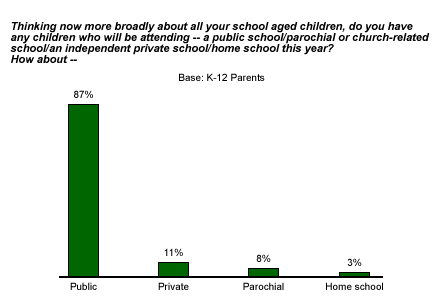Where were America's 54 million schoolchildren when the bell rang this school year? Roughly 48 million, according National Center for Educational Statistics' (NCES) projections, were poised to learn in public schools, and 6 million were in private schools. Gallup's August 2004 Work and Education poll* also indicates that the vast majority of American children attend public schools: 87% of U.S. parents of school-age children report that they have children enrolled in a public school this fall. About 1 in 10 U.S. parents have a child in an independent private school, and 8% have children in a parochial school. A small percentage of parents (3%) will be home schooling their children.

How do parents decide what type of school to send their children to? The high price tag associated with private school is undoubtedly a significant factor for most parents. But many parents also say that their decisions are influenced by where they live. Jamie Davis, a Maryland mother with one seventh-grader and one fifth-grader, sends her children to public school and is happy with the schools they attend.
"When I was house-hunting, the school system was a big part of my decision as to what county in Maryland I wanted to live in, even though I didn't have any children at that time," Davis says.
Elizabeth, a California mother of two (who requested that her last name not be used), feels that the quality of public schools "really depends on the area that you are in," and has chosen to send her oldest child to a private Montessori school for kindergarten.
The size of the sample of parents in Gallup's survey was too small to adequately analyze regional breakouts, but NCES data from 1999-2000 does indicate that levels of enrollment in private schools vary by geographic region. At that time, 7.8% of students in the Western states were enrolled in private schools, as were 8.4% in the South. The Midwestern and Eastern regions had higher rates of private school enrollment at 11.0% and 13.3%, respectively. However, enrollment in private schools decreased between 1989-1990 and 1999-2000 in each of the three regions except the South, where there was a slight increase.
Structure and style of teaching also come into play in the selection of school type. "I really like my kid's elementary school," Davis says. "The children are evaluated throughout the year and are placed in groups based on academic skill and abilities, and work on different curriculums. The school also offers gifted and talented programs in both math and reading starting in the third grade." Davis feels that class sizes are a bit too large in the public schools her children attend, but says that this problem is mitigated by the fact that student teachers are always present to help.
Elizabeth, on the other hand, is not satisfied with the format of the public schools in her area. She sends her child to a private school because it is "more structured" than the public schools.
Bottom Line
Many parents recognize that each type of school has its pros and cons, and that student success largely relies on making the most of whatever environment they're in.
Susan Robinson, a New Jersey mother of two college-age sons who sent her children to both public and private schools, feels that private school definitely has its benefits. "We noticed from our son's experience at [private school] that he learned amazing study habits, and played a variety of sports while nourishing his academics." However, she does not discount the importance of her children's time in public school: "Our sons say they learned to be street-wise in public school and to communicate with students from all backgrounds. They say that they will always appreciate the opportunity to be with such a culturally diverse student population."
*Results are based on telephone interviews with 291 public school parents with children in grades K-12, conducted Aug. 9-11, 2004. For results based on this, one can say with 95% confidence that the maximum margin of sampling error is ±6 percentage points.